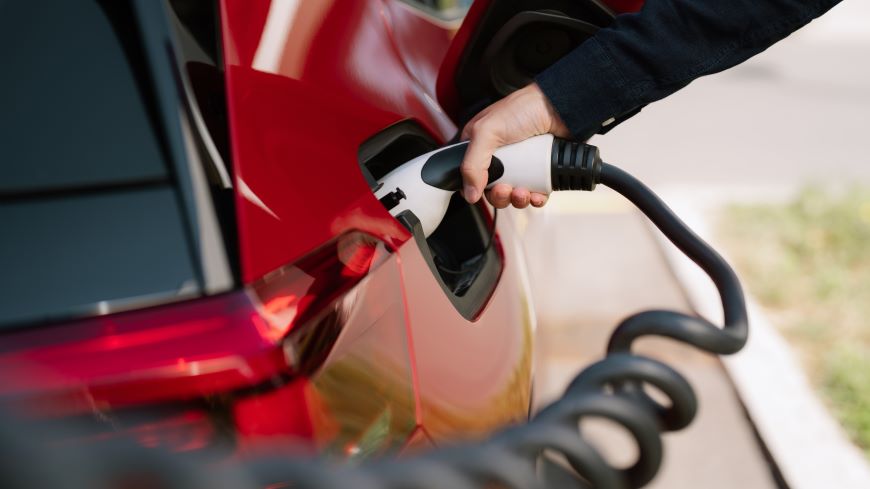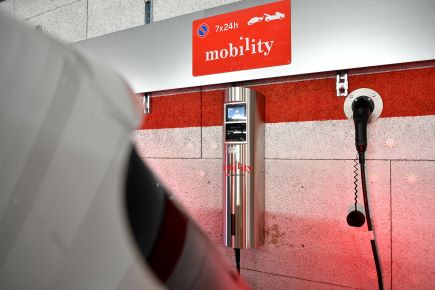The path to sustainable mobility
Electric car sharing and smart charging
Electric cars are indispensable for climate-friendly mobility. They are most effective when e-vehicles are shared and charged intelligently. Real-time information on electricity prices and CO₂ emissions is crucial for this. This is demonstrated by a study based on extensive car-sharing usage data conducted by researchers at Empa and the University of Geneva.

More electric drives systems and fewer cars – this is how emissions from traffic can be significantly reduced. Electric vehicles offer particularly great potential with car sharing. However, not all electricity is created equal: Depending on the time of day, both the energy mix (and thus the resulting CO₂ emissions) and the price for electricity vary. Using data from around 1.5 million users of the car-sharing provider Mobility, Empa researchers analyzed the emission-dependent charging of electric cars. Their result: Low electricity prices – i.e. cost-savings – and low emissions can rarely be achieved simultaneously. Those who look for the cheapest tariff over the course of the year can save an average of 21% of the costs. On the other hand, those who charge in the most climate-friendly way can reduce their emissions by up to 82 percent. “A key challenge is to combine cost and emission targets,” says study author Sven Eggimann. “Ideally, it should also pay off financially to charge electric vehicles in a climate-friendly way.”
Real-time tariff models in high demand

The study's calculations are based on hourly electricity price fluctuations. However, if only rough tariff models with day-night differences are offered, smart charging becomes tricky. “Most people in Switzerland don't know what the actual electricity price or CO₂ emissions are at the moment of charging,” says Empa researcher Elliot Romano. In order to enable charging strategies that protect the environment or reduce costs, users need real-time information – ideally via smart electricity meters. “In countries such as Denmark, users can see the current electricity price via an app and can consciously choose their charging times,” adds Eggimann. “It works – but no one wants to do it manually in the long term.” Thus, what is needed are automated systems that can be adjusted to individual preferences.
Appropriate incentive systems – such as a CO₂ price or corresponding electricity tariffs – are also needed to make charging during low-emission periods worthwhile. Simulations by the Empa team show that with a CO₂ price of around 30 cents per kilogram of CO₂ equivalent, climate-friendly and price-optimized charging can indeed be combined – but only with dynamic tariffs that reflect the real emissions of electricity consumption. “Ideally, charging should be based on voluntary measures supported by incentives,” says Romano. “These include, for example, cheaper electricity tariffs or reserved parking spaces during low-emission periods.” Otherwise, charging access could be restricted or inflexible charging behavior could be subject to additional fees.
Driven more frequently during the day, yet still environmentally friendly
Shared vehicles are on the road more frequently and more often during the day – and therefore need to be charged more overnight, when the electricity mix tends to be less climate-friendly. Nevertheless, according to Eggimann, the total emissions and costs differ only slightly compared to private vehicles. “Although shared cars are used more intensively, short charging breaks and increasingly available fast-charging infrastructure leave enough leeway for low-emission charging.”
Car sharing promises to significantly reduce the number of vehicles on the road. With 25 percent fewer cars in Swiss cities, the strain on the electricity supply in winter could be noticeably reduced. “Car sharing requires less energy overall because there are fewer vehicles on the road,” explains Romano. “Even if the number of kilometers driven annually remains similar to that of privately used cars, other means of transport are increasingly being used in addition to shared vehicles. This relieves the burden on the system as a whole.”
The crux of the matter: wintertime
For a sustainable transport revolution, electric vehicles should therefore not be viewed in isolation from optimized electric charging. “This requires further developments at the regulatory and technical level,” says Eggimann. “In the long term, however, the goal is clear: a charging infrastructure that automatically guides its users to low-emission and cost-effective charging times – without them having to constantly make decisions themselves.”
If Switzerland is to focus more on electric cars in the future, the energy system will have to be adapted accordingly. Even with optimized charging times and a reduced vehicle fleet due to car sharing, the additional electricity demand resulting from the electrification of private mobility remains considerable – with a simulated winter deficit of around one terawatt hour per month in 2050. “This seasonal supply deficit cannot easily be remedied with additional batteries or shifting charging times,” explains Romano. “Electrification is therefore only part of the solution. If you really want to do something for the climate, you should rely on car sharing, public transport – and drive less overall.”
Dr. Elliot Romano
Urban Energy Systems
Phone +41 58 765 48 27
E Romano, B Koirala, M Rüdisüli, S Eggimann: Emission-Responsive Charging of Electric Cars and Carsharing to Improve the Security of Electricity Supply for Switzerland; Environmental Science & Technology (2025); doi: 10.1021/acs.est.4c13270
-
Share






